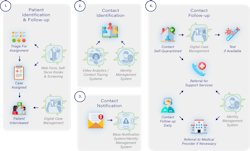In April of 2020, I wrote an article for our Faith Group blog title “Searching for the Silver Bullet” (https://www.faithgroupllc.com/public-wellness-blog/), a post that sought to get a handle on what was going on in the marketplace and how Airports were currently reacting to the COVID-19 pandemic. In writing this article for Airport Business, I wanted to put pen to paper to reflect– what have we learned almost 6 months later,and what was fundamentally missing from our recommendations? Additionally, and more importantly, what are the technologies we have seen that have worked and what does a post-pandemic future look like for these technical applications?
I think Airports, like many customer facing organizations, have had to deal with COVID-19 from 2 perspectives – The safety of the traveling public and the safety of internal staff. We’ve seen a significant amount of investment on both sides of the industry, with varying levels of deployment and unfortunately, not a lot of measurable effectiveness within the aviation industry.
In April, Faith Group was advocating 4 different core approaches that Airport organizations should consider to ensure the safety of both their staff and passengers:
- Thermal Screening
- Touchless Travel
- Air Filtration
- Mask Requirements
These have been common sense recommendations which have held true throughout the pandemic. Faith Group and the epidemiologist community as a whole, has recommended a layered approach for COVID management. Findings have held true that prevention is not enough and organizations also need to be able to suppress the severity of an outbreak. Airport’s must evaluate how they not only reduce likelihood, but also severity, of an outbreak.
One of the key items that we had not considered at the time, was the requirements for contact tracing within an organization. As has been shown by multiple COVID and infectious disease models, quickly identifying super spreaders and their downstream contacts is one the most effective ways in controlling spread in a population. In March and April, it’s was assumed that Contact Tracing efforts would be coordinated at a state and federal governmental level, but now, the key severity of outbreak reducer is also the responsibility of Airports and other organizations.
Many large Airports now have a formal manual process in place, but what are the contact tracing technologies out there? There have been a lot of different approaches, with multiple showing pros and cons for deployment. They include:
- Phone Based
- External RFID and Bluetooth
- Video Analytics
- Access Control
Google and Apple both worked on a smartphone based approach, but at an organizational level, this just isn’t feasible. The accuracy of smart phone based solutions just doesn’t meet the needs of organizations with multiple individuals working indoors (or even outdoors, for that matter). Complicating the matter, you have updated CDC time guidelines, where it’s not just contact, but it’s contact over time that matters the most. Airports need the ability to effectively manage who came into contact with who and how long were they in contact.
The desired outcome for any contact tracing program is to rapidly identify infected individuals, identify their close contacts (as defined by the current standards) and direct these individuals appropriately into isolation or quarantine to stop disease transmission. The key point in contact tracing, that is often overlooked, is you need some system to actually track an identity! Most public facilities, Airports being a leading example, don’t have this ability for anyone that doesn’t carry an Airport badge. This has unfortunately made contact tracing, for Airport passengers, not a viable option.
That said, airports have considerable investment in current technology systems therefore the initial approach should be to assess how current technology can be repurposed to deliver the desired outcome. Many Airports already have manual contract tracing projects, but if not, an organization should start by documenting the specific business process flows that are currently being conducted manually and look for opportunities to improve the current concept of operations. Whatever the technology selected for contact tracing, there will still be a requirement for manual review. Contact tracing technologies accelerate response and accuracy, but they do not replace the human element in the process.
Successful deployments have then matched business process to capable technology systems. The typical core systems that should be assessed should include:
- Identity Management Systems
- Video Management Systems
- Mass Notification Systems
- Cellular Systems
- Badging and Access Control
Airports have a significant investment in camera systems that can be enhanced through the use of Video Analytics. A major benefit in utilizing your video system for this type of analytic, is there are multiple packages available in the marketplace that can generate a lot of other actionable information beyond just COVID. As described in the beginning of this article, COVID focused technologies need to have future uses cases beyond just infectious disease prevention to be successful and viable for investment by the organizations. While COVID will still be a part of our world through the end of 2021, there is a light at the end of the tunnel and investments should be pivotable or usable for additional use cases (or applicable to Flu Season).
Faith Group has seen video systems used, with a high degree of success, for the following:
► Thermal Screening
► Video-Based Contact Tracing
► Automated Facemask Detection
► Social Distancing Analytics and “Hot-Spot” Detection
► Occupancy Sensing and Threshold Enforcement
Whatever technical choice made, Airport’s should develop a proof of concept (POC) to pilot initial concept of operation automation improvements. The POC should focus on the utilization of a variety of Common Off the Shelf (COTS) hardware and software (as listed above), to address the highest risk factors, assembled and integrated into a cohesive environment which delivers functionality targeted at improving the airports capability to actively manage and respond to the COVID-19 pandemic. The POC for contact tracing technology is also a great opportunity to evaluate some of the following questions as well:
- How will individuals who have come in contact be identified?
- What are your Airport’s guidelines that must be followed within your program?
- What will your Airport do and/or restrict for individuals who have been positively identified? Will other systems, such as card access, also have inputs based on this outcome?
Finally, your platform (or collection of technologies) is ready to go
and following this multiple step process, an Airport will be ready to deploy. Your typical steps, in any contact tracing automation platform, should follow CDC guidelines.
All of that said, while this is effective internally for staff, its increasingly difficult to do this for passengers who are coming through the Airport. Contact tracing, for passengers, the aviation industry has not only struggled with the technical aspects, but what role do they play?
The single point of an effective contact tracing program is the ability to actually identify an individual and get in contact then with them. While this may seem obvious, it’s worth making extremely clear. Airport’s in the US have long struggled with not knowing who actually their individual passengers are. This may work in foreign countries, with limited points of entry and passenger data shared from the Airlines, but in the US, we just don’t know.
Airport’s who have been most successful have focused on prevention and mitigation strategies that take a broad brush approach, specifically focused on:
- Biometrics, Touchless Travel and Self Service Passenger Check In
- Smart Restrooms
- Air Quality Improvements
- Maintaining Social Distancing Requirements
- Enforcing Mask Wearing to Prevent Spread
- Enhanced Cleaning Procedures
Airport’s need to continue to focus on technologies and operational changes that continue to restore confidence in air travel and not only that, enhance capabilities in the future! Biometrics, Touchless Travel and Self Service options have been a long term trend prior to COVID and is one that we have only seen accelerated by the pandemic. Video analytics, hot spot detection, live occupancy monitoring and many other IoT outcomes have also been an emerging trend, as Airport’s have sought to better understand the aggregate behavior of their travelers.
Most Airport’s have already made some level of investment, or at least operational changes, for their internal staff and employees. An emerging trend at many organizations is the utilization of case management software. As has been repeated multiple times, tracking of identities, their current status and overall availability in the organization has grown increasingly complex, especially in Airports and organizations with hundreds or many thousands of employees. As individuals begin to receive vaccines at the end of this year and throughout 2021, this level of management will only become more important; your HR platform, or identity management platform, is a great place to start (and you can use the steps above to evaluate how to implement!)
All of the technologies, processes and trends listed above have only put more pressure on Airport Operations and IT groups and for many of Faith Group’s clients, have highlighted the need for continued investment in digital technologies. In some cases, Airport IT groups have utilized COVID as an accelerator for their ongoing programs and for upgrades to existing technologies which have always been on “next years capital roadmap”. As pressures have come onto the industry, costs are lower for implementation than a year ago and traffic is lower, streamlining in-terminal implementations. As Winston Churchill famously said “Don’t let a good crisis go to waste”.
Zach Varwig, Director of Technology and Innovation – Zach Varwig leads the development of innovative solutions, technology, and strategy for Faith Group, with a focus on Aviation clients. His expertise is rooted in project management, technology impact evaluation and operations analysis, along with technology concept generation and business case development. Zach has worked at 20+ Airports nationwide, on a wide variety of projects and initiatives. He has led the Faith Group technical response to COVID-19, having been responsible for investigation and research into hundreds of potential technical products and solutions to support detection, mitigation, and response efforts.







